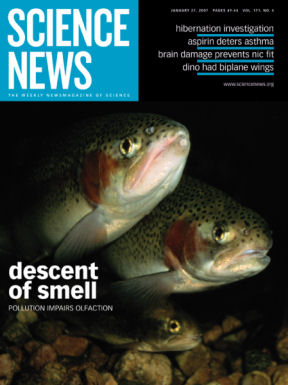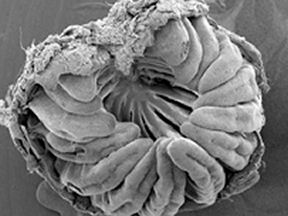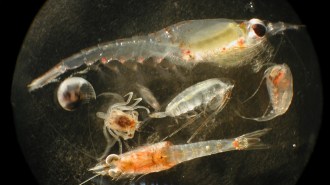People complain about the way that fish smell. But it’s the fish that should be doing the grumbling. In pristine waters, the animals smell quite well, thank you. Those tiny holes near fishes’ mouths are, in fact, nostrils through which the animals draw in water to pump over olfactory nerves. By distinguishing scents, fish find food and mates and avoid predators.



Studies decades ago, for instance, showed that mechanically plugging the nostrils of adult salmon prevented them from locating their natal streams when they attempted to return home to spawn. The fish as juveniles had recorded memories of smells as they went to sea. Without detecting the olfactory signposts, the fish couldn’t retrace their routes, says Nathaniel L. Scholz, a zoologist at the National Oceanic and Atmospheric Administration’s (NOAA’s) Northwest Fisheries Science Center in Seattle.
In a series of studies over the past 6 years, his group has demonstrated that metals and pesticides—at concentrations commonly found in streams—can impair a salmon’s sense of smell just as effectively as plugging the nostrils did. Meanwhile, other scientists have shown that such pollutants block the sense of smell in other organisms.
“What we’re finding,” says Scholz, is that “even short-term exposure to many of these pollutants—on the order of hours—can interfere with olfaction.”
Researchers have reported that the impairment can disrupt the animals’ normal behaviors in several ways. Fish use their keen sense of smell not only to navigate dark and cloudy waters but also to nose out scents indicating danger, such as chemicals from a predators’ skin.
The studies are establishing that aquatic animals exposed to pollutants miss chemical cues that have life-and-death consequences, says ecotoxicologist Gregory G. Pyle of Nipissing University in North Bay, Ontario.
Pesticidal nose plugs
Atrazine, North America’s most widely used herbicide for corn and cotton blunts a fish’s sense of smell, according to work by Keith Tierney and his colleagues at Simon Frasier University in Burnaby, British Columbia.
A 30-minute exposure to a 1 parts per billion (ppb) concentration of atrazine reduced the activity of olfactory neurons in coho salmon (Oncorhynchus kisutch) by 11 percent, the researchers reported last November at the annual meeting of the Society of Environmental Toxicology and Chemistry (SETAC) in Montreal. The animals’ neural responses to alarm odors dropped by 45 percent. Higher doses of the herbicide triggered greater losses in smell; 100 parts per million atrazine eliminated any response to a predator’s scent. River concentrations up to 20 ppb can occur briefly near farms that apply it, says Tierney.
Pure glyphosate, the active ingredient in another widely used herbicide that’s sold under a series of trade names, including Roundup, caused similar changes in salmon olfaction, although only at far higher doses than were required of the commercial herbicide formulation. At the November SETAC meeting, these researchers presented data showing that Roundup was 100 times as powerful at blocking fishes’ sense of smell as was an equal quantity of pure glyphosate.
Roundup contains a variety of ingredients added to glyphosate to increase the herbicide’s adhesion to leaves and to retard its breakdown. Although these ingredients are listed as inert components on herbicide labels, Tierney’s team concludes that they aren’t inert as far as fish olfaction is concerned.
“I’d like to find out what those inerts are,” Tierney says, but he notes that pesticide manufacturers regard them as part of their proprietary recipes.
Tierney isn’t alone in his concern over supposedly inert ingredients. Some “4.1 billion pounds of inert [pesticide] ingredients are applied annually” to the U.S. environment, Christian E. Grue of the University of Washington in Seattle and his colleagues reported at the SETAC meeting.
Because these compounds aren’t lethal to untargeted organisms, they don’t require identification on labels, the Seattle researchers note—even though the inerts may exert a subtle but substantial toxic effect on aquatic life. Grue argues that “a new regulatory strategy is needed,” which would require toxicity analyses of any supposedly inert ingredients.
Atrazine isn’t the only chemical pesticide that can suppress a fish’s ability to smell. Tierney’s group showed that at exposures of about 10 ppb, the fungicidal wood-preservative known as IPB turned off olfaction in coho salmon. The researchers described that finding in the August 2006 Aquatic Toxicology.
They also reported in the October 2006 Environmental Toxicology and Chemistry that the insecticide endosulfan and the herbicides trifluralin and 2,4-D can impair a fish’s sense of smell.
Scholz’ group, too, has made contributions to the list of pesticides that affect fish olfaction. Six years ago, that team showed that diazinon significantly impaired responses by Chinook salmon (Oncorhynchus tshawytscha) to alarm scents and reduced their success in finding their natal pools.
More recently, Scholz’ team has shown that low concentrations of the insecticide chlorpyrifos can impair olfaction in coho salmon and that the insecticide esfenvalerate can trigger abnormal neural signals in response to food scents.
Copper masks
Copper runs off agricultural lands, lawns, and urban streets. It’s an active ingredient in many pesticides, and brake pads often shed copper as they wear down. Dissolved copper diminishes a fish’s sense of smell, several researchers reported at the SETAC meeting.
Scholz’ team, for instance, reported that just 3 hours of exposure to waterborne copper reduced responses of juvenile coho salmon to a typical alarm odor, a scent that came from the skin of a wounded coho. Such chemical alarms typically make young coho dive for cover.
Juvenile salmon that had been kept in clean tanks reacted properly to the cue. They stopped swimming, ignored food, and sought refuge. Other juveniles, which had spent 3 hours in copper-tainted water, swam placidly and continued feeding after researchers spiked their water with an alarm scent. Scholz characterizes the copper-treated fish as “totally oblivious” to this whiff of danger.
The scientists went further in establishing that copper impairs the sense of smell. From several fishes’ nostrils, they recorded electrical signals carrying information to the brain from olfactory neurons. Compared with the untreated fish, copper-treated coho produced much weaker—or no—responses to the alarm scents. Scholz says that his group found “a very tight relationship” between the fishes’ behavior and olfactory neuron signals.
Reehan Mirza, Pyle, and their colleagues at Nipissing University have witnessed the same phenomenon in fish exposed to copper in the wild. These Canadian researchers worked with yellow perch (Perca flavescens) taken from Ontario lakes, some of which were contaminated by runoff from a copper mine. “Fish from the clean lakes responded to alarm cues,” Mirza told Science News, “while perch from the contaminated lakes did not.”
Mirza’s team exposed the fish to chemicals extracted from the skin of a wounded perch or the skin of a rainbow trout, a perch predator. Odor sensitivity in perch from lakes with less than 2 parts per billion (ppb) copper was 2.5 times that in fish from lakes containing at least 18 ppb copper.
Dissolved copper also seems to prevent female fish from sizing up prospective mates. In seeking males that are fat and healthy, female fathead minnows (Pimephales promelas) assess a Romeo’s qualities “exclusively from chemical information,” says Pyle.
To test copper’s effects on this aspect of smell, Pyle and his colleagues raised males for a month on either a low- or a high-calorie diet. The results were emaciated, sickly looking males and specimens of minnow machismo.
A male from each category was then placed at the end of each branch of a Y-shaped maze. Egg-swollen females placed at the start of the maze couldn’t see their potential mates but could pick up the males’ scents. In nearly every case where the female had come from a clean lake, she headed toward the larger male. Females from copper-tainted lakes, by contrast, showed no preference between the candidates.
The researchers then built a glass cage in which the females could see but not smell potential mates. In this case, females from both the clean and copper-tainted lakes showed no preference for robust males. Pyle concludes that females can’t compensate visually for their lack of smell.
“This can have implications on the subsequent gene pool,” he told Science News. “If you’re not picking the optimal mate, there’s an increasing probability that that next generation won’t be as successful in their environment.”
Beyond fish
Pyle and his colleagues have also shown effects of copper-mine runoff on leeches and water fleas. The team began investigating the metal’s impact on leeches after hearing reports from anglers who observed that leeches, aquatic relatives of the earthworm, appeared to inhabit only the lakes around Sudbury, Ontario, that weren’t polluted by copper-mine wastes.
Pyle explains that the local leech, Nephelopsis obscura, is “effectively blind—and therefore relies almost exclusively on chemical information [scents] to locate food.”
The researchers collected leeches from clean lakes and then put some in water with copper at concentrations of either 10 or 20 ppb. After 2 to 16 days of such exposure, each leech was placed in a clean-water tank containing a Y-shaped maze. One arm of the maze was baited with beef liver.
Copper-exposed leeches had trouble identifying the path to the food, and the longer they had been exposed to the metal the less likely they were to succeed. Leeches unexposed to copper invariably found the meal unless the researchers laced the maze water with copper. Then, Pyle notes, these leeches, too, swam “randomly, no longer able to discriminate food scents.”
Even more telling, Pyle says, were tests in which his group placed a leech in a fishbowl of clean water along with a dead minnow. If the leech had been living in clean water, it immediately swam to the fish and began feeding. However, leeches that had spent a week in water with at least 5 ppb copper had trouble locating the minnow.
Pyle says that some Sudbury-area lakes have up to 30 ppb copper concentrations—and no leeches. Unable to smell their next meal, the animals there may have all starved, he concludes.
His team has also studied copper’s effect on a tiny water flea (Daphnia pulex)—a crustacean about 2.5 millimeters long—that serves as the bottom rung on many lake-animal food ladders. Larvae of an insect known as the phantom midge (Chaoborus americanus) are among Daphnia’s predators. The larvae release an odor when they feed on the water fleas. Young Daphnia that pick up the scent respond, over several days, by developing neck spines that make the tiny animals too big for a larval midge’s mouth.
In lab tests, however, Daphnia housed in water containing as little as 5 ppb copper developed few if any protective neck spines in response to the midge scent.
Growing concerns
Pesticides typically reach streams via runoff when rains hit a recently treated farm, forest, or lawn. Roadways, storm drains, and paved and plowed land facilitate quick pollutant runoff into surface waters, Scholz says. His NOAA team now simulates such intermittent pollutant exposures.
In these circumstances, a pollutant-induced shutdown of fishes’ sense of smell may last only a few hours. However, in some regions, pulses of polluted storm water “may come through so frequently that fish never effectively recover,” Scholz says. Increasing runoff in areas of growing urban and rural development may explain why salmon are disappearing from streams throughout the West, he proposes.
Pyle notes that pesticides and copper at concentrations similar to those in the environment knock out olfactory communications in every species tested to date—whether water fleas, leeches, or fish. He told Science News, “The apparent ubiquity of this phenomenon is, well, quite disturbing.”
Correction: This article misidentified glyphosate. This herbicide is the active ingredient not in atrazine but in a range of products such as Roundup. Studies in Canada have shown that both atrazine and glyphosate can impair fish olfaction.







